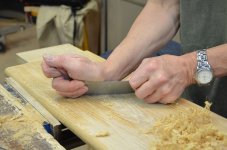ear3
Member
- Joined
- Jul 24, 2014
- Messages
- 4,341
I've been giving my card scraper a lot more work recently, and am considering upgrading due to the fatigue my fingers get from bending the card for long periods of time. I've been trying to read up on the difference between cabinet scrapers (basically just a holder for the blade/card) and scraping planes, but I'm still uncertain about whether the plane is basically just a souped up version of the cabinet scraper, or whether there are reasons/applications why someone would choose one over the other (other than size/sole footprint).
And then in terms of the different scraping plane options, the one difference seems to be that the LV is engineered to bend the blade slightly, while the LN keeps the blade straight. Also, does anyone know what the advantage/application of the toothed blades for the LN are?
http://www.leevalley.com/us/Wood/page.aspx?p=48431&cat=1,41182,68491
https://www.lie-nielsen.com/product/large-scraping-plane
Finally, is it it difficult to sharpen/burnish the scraping plane blade?
And then in terms of the different scraping plane options, the one difference seems to be that the LV is engineered to bend the blade slightly, while the LN keeps the blade straight. Also, does anyone know what the advantage/application of the toothed blades for the LN are?
http://www.leevalley.com/us/Wood/page.aspx?p=48431&cat=1,41182,68491
https://www.lie-nielsen.com/product/large-scraping-plane
Finally, is it it difficult to sharpen/burnish the scraping plane blade?


